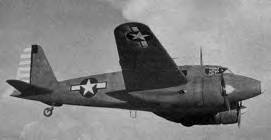![]() The Pacific War Online Encyclopedia
The Pacific War Online Encyclopedia
|
| Previous: Ki-51 "Sonia", Japanese Light Bomber | Table of Contents | Next: Ki-55 "Ida", Japanese Trainer Aircraft |

National Archives
Tachikawa Ki-54 "Hickory"
| Crew | 2 to 9 |
| Dimensions | 39'2" x 58'8" x
11'9" 11.94m by 17.88m by 3.58m |
| Weight | 6512-8591 lbs 2594-3897 kg |
| Speed | 234 mph at 6560
feet 377 km/h at 2000 meters |
| Cruise |
149 mph 240 k m/h |
| Climb rate | 13.5 feet per second 4.1 meters per second |
| Service ceiling
|
22,555 feet 7180 m |
| Power plant | Two 450 hp (336 kW) Army Type 99 nine-cylinder radial engines (Hitachi Ha-13a) driving two-blade propellers. |
| Armament | Four flexible 7.7mm Type 89 machine guns and practice bombs. |
| Range | 597 miles at 149
mph 960 km at 240 km/h |
| Production | Tachikawa Hikoki
K.K.: 1940: 7 1941: 101 1942: 236 1943: 386 1944: 500 1945: 138 |
|
Variants |
The Ki-54c was a light transports
carrying up to
8
passengers. The similar Y-59 was produced in small numbers
for civilian
use. The Ki-54d was an antisubmarine patrol aircraft carrying 8 60 kg (132 lb) depth charges. Only a few were built and they saw little action. |
The Ki-54 was a very successful
trainer that was also
produced in a transport version. The design was requested in late
1939
and was required to closely match the handling and performance of
the
Army's twin-engine bombers.
The
prototype first flew in the summer of 1940 and the design went
into
production in
1941. Though meant to train entire bomber crews, early production
was
designed primarily for pilot
training (Ki-54a). Later production (Ki-54b) had gun stations for
training four gunners.
A few were converted to antisubmarine duty. Wooden transport and tanker
versions
were planned but never went into production. Allied intelligence assigned the
name
"Joyce" to a nonexistent light
bomber version.
References
The Pacific War Online Encyclopedia © 2007, 2009 by Kent G. Budge. Index